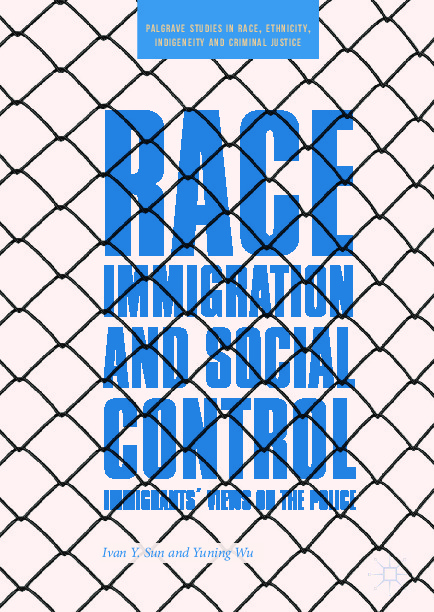File #2540: "2018_Book_RaceImmigrationAndSocialContro.pdf"
Testo
1|Foreword|6
1|Acknowledgements|8
1|Contents|10
1|List of Tables|12
1|1 Introduction|13
2|The Interplay of Race/Ethnicity, Immigration and Policing|15
2|A Focus on Three Immigrant Groups|17
2|The Organization of the Book|18
1|2 Race/Ethnicity as the Defining Characteristic of Policing in the U.S.|20
2|Theoretical Reappraisal|22
2|Disparity or Bias in Police Control|24
3|Arrest|24
3|Use of Deadly Force|29
3|Traffic Stops|31
2|Racial/Ethnic Differences in Attitudes Toward the Police|34
2|Summary|37
2|References|38
1|3 Policing the Country’s Newcomers|46
2|Keeping Them at Bay: Taming Immigrant Enclaves|47
2|Policing Increasingly Diverse Immigrant Communities Before 9/11|52
2|Surfacing Challenges in the Post-9/11 Era of Policing|57
2|Summary|61
2|References|63
1|4 The Apparent Immigrants: Latinos’ Attitudes Toward the Police|67
2|The Convenient but Disadvantaged Immigrants|68
2|Unequally Targeted by Law Enforcement|71
2|Latino Perceptions of the Police|74
2|Summary|80
2|References|81
1|5 Model Minorities and Forever Foreigners: Chinese Americans’ Attitudes Toward the Police|88
2|Immigration History, Contemporary Communities, and Racial Relations|89
2|Experience with Crime and Criminal Justice|95
2|Chinese Americans’ Attitudes Toward the Police|99
2|Summary|107
2|References|108
1|6 From Invisibility to Unwanted Spotlight: Arab Americans’ Perceptions of the Police|116
2|Arab Americans and Their Communities|117
2|Arab Americans and Law Enforcement|119
2|Arab American Perceptions of the Police|122
2|Summary|130
2|References|131
1|7 More Than Blacks and Whites: Theory Development on Immigrant Perceptions of the Police|136
2|Differential Attitudes Toward Police Across Groups|137
2|Integrated Conceptual Model|139
3|Universal Variables 1: Demographic|141
4|Group Position Theory|141
4|Racial Hierarchy Theory|142
4|Socioeconomic Resource Thesis|143
3|Universal Variables 2: Experiential|144
3|Institutional Performance Theory|145
3|Universal Variables 3: Structural|146
4|Social Disorganization Theory|146
4|The Community Accountability Perspective|148
3|Universal Variables 4: Attitudinal|148
4|The Sense of Injustice Perspective|149
4|The Group Consciousness Theory|150
3|Immigrant-Specific Variables 1: Demographic|152
4|The Immigrant Paradox Thesis|152
4|The Theory of Assimilation|154
3|Immigrant-Specific Variables 2: Experiential|155
4|The Imported Socialization Theory|156
4|The Contrast Thesis|157
4|The Trust-Transference Hypothesis|157
3|Immigrant-Specific Variables 3: Structural|158
4|The Critical Citizen Thesis|159
3|Immigrant-Specific Variables 4: Attitudinal|160
4|The Cultural Thesis|160
2|Future Testing of the Conceptual Model|161
2|Summary|162
2|References|163
1|8 Summary and Conclusion|172
2|What We Have Learned|173
2|Directions for Future Research|176
2|Policies and Programs to Consider|180
2|References|182
1|Index|185
1|Acknowledgements|8
1|Contents|10
1|List of Tables|12
1|1 Introduction|13
2|The Interplay of Race/Ethnicity, Immigration and Policing|15
2|A Focus on Three Immigrant Groups|17
2|The Organization of the Book|18
1|2 Race/Ethnicity as the Defining Characteristic of Policing in the U.S.|20
2|Theoretical Reappraisal|22
2|Disparity or Bias in Police Control|24
3|Arrest|24
3|Use of Deadly Force|29
3|Traffic Stops|31
2|Racial/Ethnic Differences in Attitudes Toward the Police|34
2|Summary|37
2|References|38
1|3 Policing the Country’s Newcomers|46
2|Keeping Them at Bay: Taming Immigrant Enclaves|47
2|Policing Increasingly Diverse Immigrant Communities Before 9/11|52
2|Surfacing Challenges in the Post-9/11 Era of Policing|57
2|Summary|61
2|References|63
1|4 The Apparent Immigrants: Latinos’ Attitudes Toward the Police|67
2|The Convenient but Disadvantaged Immigrants|68
2|Unequally Targeted by Law Enforcement|71
2|Latino Perceptions of the Police|74
2|Summary|80
2|References|81
1|5 Model Minorities and Forever Foreigners: Chinese Americans’ Attitudes Toward the Police|88
2|Immigration History, Contemporary Communities, and Racial Relations|89
2|Experience with Crime and Criminal Justice|95
2|Chinese Americans’ Attitudes Toward the Police|99
2|Summary|107
2|References|108
1|6 From Invisibility to Unwanted Spotlight: Arab Americans’ Perceptions of the Police|116
2|Arab Americans and Their Communities|117
2|Arab Americans and Law Enforcement|119
2|Arab American Perceptions of the Police|122
2|Summary|130
2|References|131
1|7 More Than Blacks and Whites: Theory Development on Immigrant Perceptions of the Police|136
2|Differential Attitudes Toward Police Across Groups|137
2|Integrated Conceptual Model|139
3|Universal Variables 1: Demographic|141
4|Group Position Theory|141
4|Racial Hierarchy Theory|142
4|Socioeconomic Resource Thesis|143
3|Universal Variables 2: Experiential|144
3|Institutional Performance Theory|145
3|Universal Variables 3: Structural|146
4|Social Disorganization Theory|146
4|The Community Accountability Perspective|148
3|Universal Variables 4: Attitudinal|148
4|The Sense of Injustice Perspective|149
4|The Group Consciousness Theory|150
3|Immigrant-Specific Variables 1: Demographic|152
4|The Immigrant Paradox Thesis|152
4|The Theory of Assimilation|154
3|Immigrant-Specific Variables 2: Experiential|155
4|The Imported Socialization Theory|156
4|The Contrast Thesis|157
4|The Trust-Transference Hypothesis|157
3|Immigrant-Specific Variables 3: Structural|158
4|The Critical Citizen Thesis|159
3|Immigrant-Specific Variables 4: Attitudinal|160
4|The Cultural Thesis|160
2|Future Testing of the Conceptual Model|161
2|Summary|162
2|References|163
1|8 Summary and Conclusion|172
2|What We Have Learned|173
2|Directions for Future Research|176
2|Policies and Programs to Consider|180
2|References|182
1|Index|185

